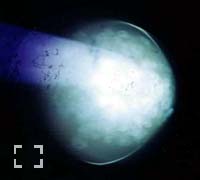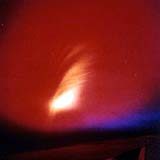 |
|
Operation Fishbowl - 1962

Kingfish 01/11/1962
|
Operation Fishbowl was a high altitude nuclear test series conducted in 1962, as part of the larger Operation Dominic program. Previous high-altitude nuclear tests during Hardtack I and Argus had provided insufficient data on the effects of high altitude nuclear detonations, necesitating further testing during Operation Dominic. The Fishbowl tests were originally planned for the first half of 1962, with three tests named Bluegill, Starfish and Urraca. However, the first test attempt was actually delayed until June.
Planning for Operation Fishbowl was begun rapidly in response to the sudden Soviet announcement on 30 August 1961 that they were ending a three year moratorium on nuclear testing. The rapid planning of very complex operations necessitated many changes as the project progressed. A test named Kingfish was added during the early stages of Operation Fishbowl planning. Two low-yield tests, Checkmate and Tightrope, were also added during the project, bring the the final number of tests to 5.
All of the tests were launched on missiles from Johnston Island, as this location had already been established as high-altitude nuclear test base. Despite Johnston Islands remote location, there were fears that the flash from the nighttime high-altitude detonations might cause permanent retinal injury to people living in the Hawaiian Islands. The nuclear missiles of Operation Fishbowl were launched generally toward the southwest of Johnston Island, increasing the distance from Hawaii.
There were three phenomena in particular that required further investigation:
1. The effects of electromagnetic pulse generated by a high-altitude nuclear explosions.
2. Blackout of radio communication in relation to military operations.
3. The auroras associated with high-altitude nuclear explosions, especially the auroras that appeared almost instantaneously far away from the explosion in the opposite hemisphere.
It was known from previous high altitude tests, that charged particles released from nuclear explosions can travel in a spiral along the magnetic field lines that arc high above the Earth, until they reach the magnetic conjugate area in the opposite hemisphere. Charged particles traveling along the Earth's magnetic field lines can cause auroras and other geophysical phenomena in the conjugate areas. These charged particles can also be reflected back and forth along the magnetic field lines, forming artificial radiation belts. These effects can persist for long periods of time, up to several months or longer.
As with all U.S. Pacific high-altitude nuclear tests, all of the Operation Fishbowl tests were completed at night. This was in contrast to the Soviet high-altitude tests of the K Project, which were done over the populated land region of central Kazakhstan, and therefore had to be done during the daytime to avoid eyeburn damage to the population.
According to the initial plan of Operation Fishbowl, the nuclear tests were to be Bluegill, Starfish and Urraca, in that order. If a test were to fail, the next attempt of the same test would be of the same name plus the word "prime." For example, if Bluegill failed, the next attempt would be "Bluegill Prime," and if "Bluegill Prime" failed, the next attempt would be "Bluegill Double Prime," etc.
The Tests
Bluegill - 02/06/1962
The first planned test was launched from Johnston Island on a Thor missile just after midnight. Although the missile appeared to be on a normal trajectory, the radar tracking system lost track of the missile. The range safety officers ordered the missile with its warhead to be destroyed. No nuclear detonation occurred and no data was obtained.
Starfish - 19/06/1962
The Thor missile flew a normal trajectory for 59 seconds before the engine failed and the missile began to break apart. The range safety officer ordered the destruction of the missile and the warhead at an altitude of between 9 and 10 km. Some of the missile parts fell on Johnston Island, and a large amount of missile debris fell into the ocean in the vicinity of the island.
Starfish Prime - 09/07/1962

Starfish Prime
|
On 9 July 1962, at 09:00 UTC, the Starfish Prime test was successfully detonated at an altitude of 400 kilometres about 29 kilometers southwest of Johnston Island. The actual weapon yield was very close to the nominal design yield of 1.45 megatons. The Thor missile carrying the Starfish Prime warhead reached height of about 1100 km. The warhead was detonated on its downward trajectory when it had fallen to the programmed altitude of 400 kilometres.
Starfish Prime caused a massive electromagnetic pulse (EMP), far larger than expected, so much larger that it drove much of the instrumentation off scale, destroying much of the test data. The pulse caused extensive electrical damage in Hawaii about 1,445 kilometres away, knocking out hundreds of streetlights, setting off burglar alarms and damaging telecommunications equipment.
After the detonation, bright auroras were observed in the detonation area as well as in the southern conjugate region on the other side of the equator. The effects were described as widespread and intense, with large areas of the Pacific illuminated by the auroral phenomena. The Starfish Prime radiation belt persisted at high altitude for many months, damaging or destroying a large number of American and Soviet satelites.
Bluegill Prime - 25/07/1962
A second attempt was made to launch the Bluegill device. The Thor missile engine malfunctioned, and the range safety officer destroyed the warhead with the missile still on the launch pad. The missile then exploded destroying the launch pad. It was necessary to decontaminate the entire area before the badly damaged launch pad could be rebuilt.
Operation Fishbowl test operations stopped after the disastrous failure of Bluegill Prime. Most of the personnel not directly involved in the radioactive cleanup and launch pad rebuild on Johnston Island returned to their home stations to await the resumption of tests. The Urraca event was canceled to avoid further damage to satellites and three new shots were added. A second launch pad was constructed during the operations pause so that Operation Fishbowl could continue even if there another serious accident.
After a pause of nearly three months, Operation Fishbowl was ready to continue, beginning with another attempt at the Bluegill test.
Bluegill Double Prime - 15/10/1962
Eighty two days after the failure of Bluegill Prime, another attempt was made. The Thor missile malfunctioned and began tumbling out of control about 85 seconds after launch. The range safety officer again ordered the destruction of the missile and its nuclear warhead.
Checkmate - 19/10/1962
90 minutes before midnight (Johnston Island local time), an XM-33 Strypi rocket launched a low-yield nuclear warhead which detonated successfully at an altitude of 147 km. The yield was between 10 and 20 kilotons. Observers on Johnston Island saw a green and blue circular region surrounded by a blood-red ring formed overhead that faded in less than 1 minute. Blue-green streamers and numerous pink striations formed, the latter lasting for 30 minutes. Observers at Samoa saw a white flash, which faded to orange and disappeared in about 1 minute.
Bluegill Triple Prime - 25/10/1962

Bluegill Triple Prime
|
The fourth attempt at the Bluegill test resulted in a successful detonation at about one minute before midnight local time. Although officially reported only as being in the submegaton range (meaning more than 200 kilotons but less than one megaton), most observers of the U.S. nuclear testing programs believe that the nuclear yield was about 400 kilotons.
Since all of the Operation Fishbowl tests were planned to occur during the nighttime, the potential for eyeburn, especially for permanent retinal damage, was an important consideration at all levels of planning. At the altitudes planned for the Bluegill, Kingfish and Checkmate tests, the thermal-pulse durations are of the same order of magnitude or shorter than the natural blink period which, for the average person, is about 150 milliseconds. Furthermore, the atmospheric attenuation is normally much less for a given distance than in the case of sea-level or near-sea-level explosions. Consequently, the eye-damage hazard is more severe. Two cases of retinal damage did occur with military personnel on Johnston Island during the Bluegill Triple Prime test. Neither individual had his protective goggles in
place at the instant of the detonation.
Kingfish - 01/11/1962
The Kingfish detonation was the fourth successful test of the Fishbowl series. It was officially reported only as being a submegaton explosion, but most independent observers believe that it used the same 400 kiloton warhead as the Bluegill Triple Prime test.
Johnston Island observers saw a yellow-white, luminous circle with intense purple streamers for the first minute. Some of the streamers displayed what appeared to be a rapid twisting motion at times. A large pale-green patch appeared somewhat south of the burst and grew, becoming the dominant visible feature after 5 minutes. By H+1 the green had become dull gray, but the feature persisted for 3 hours. At Oahu a bright flash was observed and after about 10 seconds a great white ball appeared to rise slowly out of the sea and was visible for about 9 minutes.
After most of the electromagnetic pulse measurements on Starfish Prime had failed because the EMP was so much larger than expected, extra care was taken to obtain accurate EMP measurements on the Bluegill Triple Prime and Kingfish tests. The EMP mechanism that had been hypothesized before Operation Fishbowl had been conclusively disproven by the Starfish Prime test. Prompt gamma ray output measurements on these later tests were also carefully obtained so that a new theory of the mechanism for high-altitude EMP could be developed and confirmed.
Tightrope - 03/11/1962
Launched on a Nike-Hercules missile, Tightrope detonated at a lower altitude than the other Fishbowl tests. The nuclear yield was reported in most official documents only as being less than 20 kilotons. At Johnston Island, there was an intense white flash. Even with high-density goggles, the burst was too bright to view, even for a few seconds. A distinct thermal pulse was also felt on the bare skin. A yellow-orange disc was formed, which transformed itself into a purple doughnut. A glowing purple cloud was faintly visible for a few minutes."
Tightrope was the final atmospheric test conducted by the United States.
Successful High-Altitude Nuclear Tests of Operation Fishbowl
| Video |
Name |
Yield |
Date |UTC| |
Type |
Warhead |
Location |
LONG/LAT |
 |
Starfish Prime |
1.4 Mt |
09:00 09/07/1962 |
Missile @400km |
W-49 |
Johnston Isl. |
17.20000 -169.10000 |
 |
Checkmate |
20 Kt |
07:30 20/10/1962 |
Missile @147Km |
XW-50X1 |
Johnston Isl. |
16.00000 -169.50000 |
 |
Bluegill Triple Prime |
400 Kt |
08:59 26/10/1962 |
Missile @48200m |
W-50 |
Johnston Isl. |
16.90000 -169.20000 |
 |
Kingfish |
400 Kt |
11:10 01/11/1962 |
Missile @96300m |
XW-50 |
Johnston Isl. |
16.60000 -169.40000 |
 |
Tightrope |
20kt |
10:30 04/11/1962 |
Missile @21Km |
W-31 |
Johnston Isl. |
17.10000 -169.10000 |
|
- Click on a thumbnail for a larger version
|
|
|
|
 |





